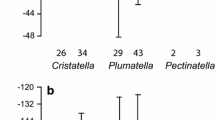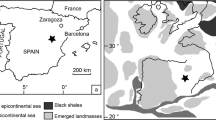Abstract
The relationship between seasonal changes in temperature and the size of zooids within cheilostome bryozoans is explored by comparing zooid size and contemporaneous carbonate mineralogy within a single colony of a perennial species that grew in a highly seasonal environment. Previously published oxygen isotope profile data from two fronds of a large colony of Pentapora foliacea from the Irish Sea record the cyclical patterns related to seasonal changes in temperature experienced by the colony over 3 years of growth. Zooid size data gathered from the same points at which the oxygen isotope data were taken reveal that zooid size and contemporaneous δ18O values covary. These and previously published data show that zooid size profiling can be confidently used to easily estimate rates of growth and longevity of bryozoan colonies, and further illustrate the negative relationship between zooid size and ambient temperature. Some inconsistencies in timing between zooid size and δ18O data may provide insights into the mechanisms behind temperature mediated body size changes in poikilothermic animals.




Similar content being viewed by others
References
Angilletta MJ, Dunham AE (2003) The temperature-size rule in ectotherms: simple evolutionary explanations may not be general. Am Nat 162:332–342
Atkinson D (1994) Temperature and organism size—A biological law for ectotherms? Adv Ecol Res 25:1-58
Atkinson D (1995) Effects of temperature on the size of aquatic ectotherms: exceptions to the general rule. J Therm Biol 20, 61–74
Atkinson D (1996) Ectotherm life-history responses to developmental temperature. In: Johnston IA, Bennett AF (eds) Animals and temperature. Phenotypic and evolutionary adaptation. Cambridge University Press, Cambridge, pp 183–204
Atkinson D, Sibly RM (1997) Why are organisms usually bigger in colder environments? Making sense of a life history puzzle. Trends Ecol Evol 12:235–239
Bader B (2000) Life cycle, growth rate and carbonate production of Cellaria sinuosa. In: Herrera Cubilla A Jackson JBC (eds) Proceedings of the 11th International Bryozoology Conference, Smithsonian Tropical Research Institute, Balboa, Republic of Panama, pp 136-144
Barnes DKA (1995) Seasonal and annual growth in erect species of Antarctic bryozoans. J Exp Mar Biol Ecol 188:181–198
Berrigan D Charnov EL (1994) Reaction norms for age and size at maturity in response to temperature: a puzzle for life historians. Oikos 70:474–478
Blight SP, Bentley TL, Lefèvre D, Robinson C, Rodrigues R, Rowlands J, Williams PJL (1995) Phasing of autotrophic and heterotrophic plankton metabolism in a temperate coastal ecosystem. Mar Ecol Prog Ser 128:61–75
Brey T, Gutt J, Mackensen A, Starmens A (1998) Growth and productivity of the high Antarctic bryozoan Melicerita obliqua. Mar Biol 132:327–333
Gowen R, Bloomefield S (1996) Chlorophyll standing crop and phytoplankton production in the western Irish Sea during 1992 and 1993. J Plankton Res 1996 18:1735–1751
Hunter E, Hughes R (1994) The influence of temperature, food ration and genotype on zooid size in Celleporella hyalina (L.). In: Hayward PJ Ryland JS Taylor PD (Eds) Biology and palaeobiology of bryozoans. Olsen and Olsen, Fredensburg, pp 83–86
Jackson JBC (1983) Biological determinants of present and past sessile animal distributions. In: Tevesz MJS McCall PL (eds) Biotic interactions in recent and fossil benthic communities. Plenum, New York, pp 39–120
Jones DS (1998) Isotopic determination of growth and longevity in fossil and modern invertebrates. In: Norris RD Corfield RM (eds.) Isotope paleobiology and paleoecology. Paleontol Soc Pap, vol 4
McKinney FK, Jackson JBC (1989) Bryozoan evolution. Unwin Hyman, Boston
Menon NR (1972) Heat tolerance, growth and regeneration in three North Sea bryozoans exposed to different constant temperatures. Mar Biol 15:1-11
Morris PA (1976) Middle Pliocene temperature implications based on the bryozoa Hippothoa (Cheilostomata-Ascophora). J Paleontol 50:1143–1149
Needham LL, Hageman SJ, Todd CD (2003) Effect of food concentration and genotype on hard-part morphology of the marine bryozoan, Electra pilosa (L.). Geological Society of America abstracts with Programs vol 34, no. 7
O’Dea A (2003) Seasonality and variation in zooid size in Panamanian encrusting bryozoans. J Mar Biol Assoc UK 83:1107–1108
O’Dea A, Jackson JBC (2002) Bryozoan growth mirrors contrasting seasonal regimes across the Isthmus of Panama. Palaeogeogr Palaeocl Palaeoecol 185:77–94
O’Dea A, Jackson JBC (2003) Coastal seasonality during closure of the Isthmus of Panama. Geological Society of America, 2003 Annual Meeting 119:11
O’Dea A, Okamura B (1999) The influence of seasonal variation in temperature, salinity, and food availability on module size and colony growth in the estuarine bryozoan, Conopeum seurati. Mar Biol 135:581–588
O’Dea A, Okamura B (2000a) Cheilostome bryozoans as indicators of seasonality in the Neogene epicontinental seas of Western Europe. In: Herrera-Cubilla A, Jackson JBC (eds) Proceedings of the 11th International Bryozoology Association Conference. Smithsonian Tropical Research Institute, Balboa, Republic of Panama, pp 74–86
O’Dea A, Okamura B (2000b) Intracolony variation in zooid size in cheilostome bryozoans as a new technique for investigating palaeoseasonality. Palaeogeogr Palaeoclimatol Palaeoecol 162:319–332
O’Dea A, Okamura B (2000c) Life history and environmental inferences through retrospective morphometric analysis of bryozoans: a preliminary study. J Mar Biol Assoc UK 80:3596–3599
Okamura B (1987) Seasonal changes in zooid size and feeding activity in epifaunal colonies of Electra pilosa. In: JRP Ross (Ed) Bryozoa: present and past. Western Washington University, pp 197–203
Okamura B, Bishop JD (1988) Zooid size in cheilostome bryozoans as an indicator of relative palaeotemperature. Palaeogeog Palaeoclimatol Palaeoecol 66:145–152
Pätzold J, Ristedt H, Wefer G (1987) Rate of growth and longevity of a large colony of Pentapora foliacea (Bryozoa) recorded in their oxygen isotope profiles. Mar Biol 96:535–538
Ryland JS (1963) The species of Haplopoma (Polyzoa). Sarsia 10:9-18
Silén L, Harmélin JG (1976) Haplopoma sciaphilum sp.n., a cave living bryozoan from Skagerrak and the mediterranean. Zool Scr 5:61–66
Smith AM, Key MM (2004) Controls, variation and a record of climate change in detailed stable isotope record in a single bryozoan skeleton. Quaternary Res 61:123–133
Stebbing ARD (1971) Growth of Flustra foliacea (Bryozoa). Mar Biol 9:267–273
Stelzer CP (2002) Phenotypic plasticity of body size at different temperatures in a planktonic rotifer: mechanisms and adaptive significance. Funct Ecol 16:835–841
Acknowledgements
I would like to acknowledge M. Kunz, H. Ristedt, J. Pätzold and G. Wefer for loaning the specimens for analysis. I would also like to thank those who were acknowledged by the authors of the original isotope paper for their help; thus, P. Hayward collected the colony of Pentapora and H. Erlenkeuser, H. Willkomm and H. Cordt made the isotope measurements. M. Kirby made comments on the manuscript. This research was supported by the Smithsonian Marine Sciences Network and the Smithsonian Tropical Research Institute.
Author information
Authors and Affiliations
Corresponding author
Additional information
Communicated by P. W. Sammarco, Chauvin
Rights and permissions
About this article
Cite this article
O’Dea, A. Zooid size parallels contemporaneous oxygen isotopes in a large colony of Pentapora foliacea (Bryozoa). Marine Biology 146, 1075–1081 (2005). https://doi.org/10.1007/s00227-004-1523-3
Received:
Accepted:
Published:
Issue Date:
DOI: https://doi.org/10.1007/s00227-004-1523-3




